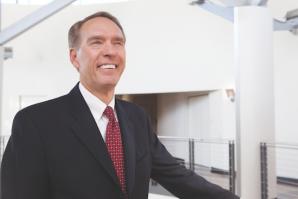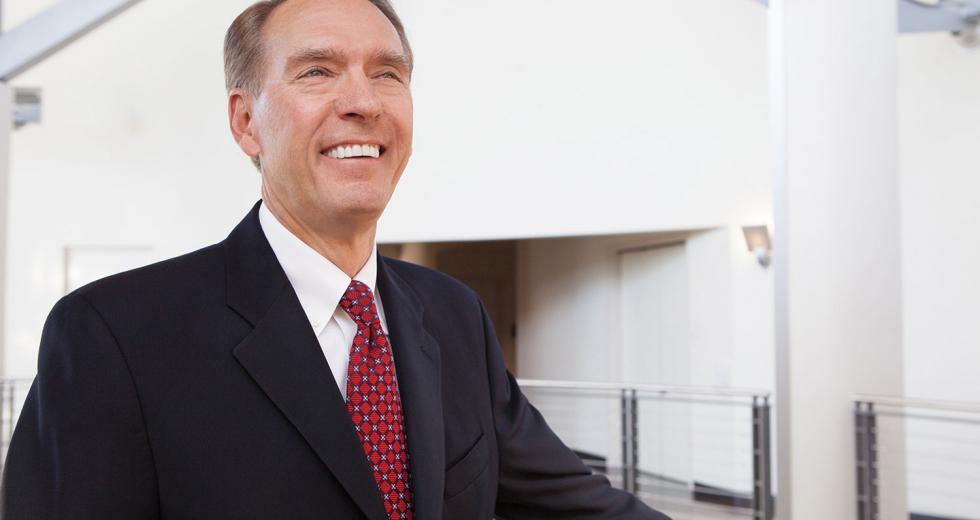For more than 40 years, Brice Harris has sat front row in the nation’s community college system. First as a part-time faculty member at a small campus in Kansas City, later as president of Fresno City College and since 1996 as chancellor of Los Rios Community College District. He has spent his career working within multi-college systems. This month, he retires.
Considered one of the most respected leaders in higher education, Harris is touted for a long list of accomplishments that includes building community education centers, leading Los Rios through two local bond measures to fund renovations and expansions at all four of the district’s colleges, and driving the development of Three Stages performing arts center at Folsom Lake College, the district’s newest campus.
When he arrived in Sacramento, Los Rios had a total student population of 50,000. In 2009 that number reached a high of 92,000.
While Harris, 64, has spent much of the past three years guiding the district through one of the most difficult budget periods in California history — due to three years of state-imposed budget cuts, enrollment currently stands at 85,000 — he says those tribulations are not reason for his departure.
“I was on track to leave in August 2011, but the worse the state budget situation got, the more the board and I felt it would be best if I stuck around another year,” Harris says. “We were fearful it would get as bad as it has. The feeling was that staff and faculty would take that kind of news better from me than from a new person.”
Comstock’s recently spoke at length with Harris about his insight on state budget cuts and their impact on the future of California Community Colleges.
BUDGET IMPACT
“Our current 2012-13 budget assumes that Gov. Brown’s tax initiative doesn’t pass. At best, its passage is 50/50. However, if it does fail, come next budget season severe cuts will take place, including an across-the-board, 6 percent salary rollback and more reductions in courses, and perhaps in students, faculty and staff as well.”
“As a state, we make major public policy decisions at the wrong time. If you think about it, the best time to make a policy change in direction is not when you have a crisis driving you. Unfortunately, that’s not the way government works. Too often, it’s crisis that drives public policy decisions.”
“At one point, access to the state’s community college system was absolutely free to all. Back in the ’50s, that decision was made because the state’s leadership believed access to education beyond the high school diploma was going to give an economic, competitive advantage to California. Over time, the state’s priorities shifted from education to other areas, such as transportation, health services and prisons. A $5 fee was added (to classes), then $8 and higher. In the past three years, it has skyrocketed to the point that it now costs $46 per unit. So we went from a no-fee environment to an ever-increasing fee situation.
“State funding continues to be unstable and uncertain. The sooner we all get off that dependency, the better we will be.”
Linda Katehi, chancellor, UC Davis
“To make sure access was still available to all, the need for state aid grew for those who can’t afford the fees. So we’re going into a higher aid situation while at the same time the state is having trouble funding that aid. Ultimately, we’re moving into a high fee and low aid scenario, and that impacts access. The best example of that is right here in the Sacramento region where, in January of 2009, we had 92,000 students enrolled in Los Rios (Community College District). That meant roughly one out of every 11 adults was attending classes at one of our campuses. That’s a very high college attendance rate. It gives the region a competitive advantage over other regions because we have a more educationally engaged populace. Because of budget cuts, today we have only 85,000 students. Even more troubling, there is no reason to believe that regional growth projections have not been realized. So we should be at 100,000 students. So now the gap is somewhere near 16,000 adults in this region that would like to be getting a higher education but can’t because we don’t have the courses.”
“Because of this budget and access situation, we’re seeing the mission of the community college narrowed. We’re still tasked with the responsibility of preparing students for transfer to four-year colleges as well as technical and vocational education. However, economic development and community service programs are being eliminated statewide. Access into the CSU and UC has also become much more difficult. The CSU system has already informed us that they are not going to take any transfer students in the spring of ’13. That’s almost unbelievable. At the UC level, to offset state funding shortages, they are pursuing more out-of-state and international students because they pay the full cost of education. That displaces in-state students in need of aid.”
“Since we don’t know how to solve the real problem, we have public debates on CEO compensation, ballroom dancing and pepper spraying. So all of the media, legislative and public attention goes to dealing with these symptoms of an underfunded system rather than addressing long-term solutions to the state’s economic woes and its ability to adequately fund higher education.
POLICY SHIFT
“The public higher education environment in California is changing without the kind of front-end policy debate that you really ought to have to make the significant changes we’re making. That’s not anybody’s fault. We’re in this economic mess. As [Gov. Jerry Brown] said at the Host Committee breakfast, ‘You can’t wave a wand and make it go away.’ He was pretty blunt about the mess the state is in and what it’s going to take to get out of it.”
“One change being discussed is the implementation of differential funding. Nursing programs are more expensive than communications. So if you’re a communications student, you’re only going to pay $100 a unit. If you’re a nursing student, you pay $120. This is going to disenfranchise a whole lot of people from a very important career. And again, it’s going to limit access. One solution would be to ask the state to increase the funding for programs like nursing. But if we go down that road, the state will likely reduce the funding for other programs.”
“I think American community colleges are the single most democratic institution in this country. If you are 18 or over, we have to accept you. If you are a 16- or 17-year-old high school dropout, you are eligible. I believe community colleges are the cornerstone of the maintenance of American democracy because they are the gateway to allow individuals to pull themselves up by the bootstraps.”
PROPRIETARY SCHOOLS
“To be eligible for federal funding of student loans, proprietary schools as well as public and private institutions must be accredited. I’m a competitive guy. I don’t mind competing with national for-profit programs. But what I hate to see is that many of these programs don’t offer a quality program, don’t provide useable skills and at the same time get students into a ton of debt. Because of this situation, congressional scrutiny—rightfully so — has been placed on these schools for enrolling federal-aid students that may not have qualified for the same loans at the public institutions.”
TECHNOLOGY
“Anybody who believes that using more technology will solve our problems, make us more efficient and dramatically cut our cost, is probably not very knowledgeable. The real cost of what we’re doing is somewhere in the neighborhood of $9,000 to $10,000 a student. We’re getting $6 a student, and I believe we are doing an unbelievable job with that money. I believe technology holds more promise at the upper-division level than it does for the gateway/beginning student that needs the support structure of a campus-based experience.”
“Technology is not inexpensive. When you launch a completely online class, it doesn’t render you a breakeven for the first two or three years. Startup costs are pretty high on the front end. Ultimately, you can save money, but it’s not the panacea that a lot of people think it is.”
WORKFORCE DEVELOPMENT
“It would be hard to find anybody in California who does not understand that one of the ways for us to get out of this economic morass is to maintain a bright, educated workforce. The linkage between employment, training and education is easy for everyone to understand. Parents get it. Students get it. Business and industry gets it. If you look at the history of the state’s economic development, an educated populace fueled all the aerospace, entertainment and technology industries. But when you go downtown to the Capitol to ask for more money, they’re going to tell you the same thing you and I would tell our own families: ‘If your bank account is empty, all the good intentions don’t matter.’”
FUTURE VISION
“On balance, I happen to be a pretty optimistic person. I do see a slow recovery. If the tax initiative doesn’t pass, the recovery will linger as long as 2017 before we’re back to the point of three years ago. Even then, the community college system will not be as broadly missioned as we were when we started. What you have to wonder is, when we finally right the ship, will the state be in a position at that point to make more public policy decisions and provide better support for public education in California?”
Recommended For You

Where is Brice Harris now?
How the education champion punked Comstock’s
We first introduced readers to Brice Harris in our “New Faces in High Places” section in Dec. of ‘96, when he became chancellor for the Los Rios Community College District. What a ride it’s been.

Renewable Resources
Los Rios prepares to roll out updated student support services
Thomas Hanns was homeless when he first enrolled in classes at Sacramento City College, one of four main campuses that make up the Los Rios Community College District.



